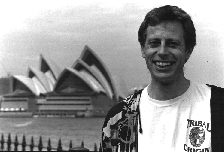Play with Objects - Clown Exercise
Alan Clay's book on clown, Angels can Fly, which will be published in May 2005, promises a mix of fiction, following the adventures of ten clown characters, some personal clown anecdotes, a total of 50 practical clown exercises, and some theory on the nature of modern clown.
The clown exercises in Angels can Fly are in the order which Alan has found best facilitates their implementation in a workshop situation, and the prerequisites to any exercise are detailed in each chapter.
The warm-up and introductory exercises are in the early chapters, the mid-session or mid-course exercises are in the middle chapters, and the more performance oriented exercises and the relaxation exercises, are in the final chapters.
So for any workshop session, it is possible to take an exercise from the start, one from the middle and one from the end, and produce a well rounded workshop structure. It is assumed that a physical warm up, of some description, would also be included at the start of any session.
The exercises have been coded for INDIVIDUAL exploration, for work in PAIRs, for WORKSHOP use, or for use in PERFORMANCE.
The following exercise is from chapter six, of fifty.
6. Explore
Play with Objects – INDIVIDUAL / PAIR / WORKSHOP / PERFORMANCE
This exercise has been one of the corner-stones of my teaching practice over the past 25 years, and it may be varied and repeated endlessly, as well as explored solo in a studio, or in a performance setting, in front of an audience.
In a workshop setting, following a physical, emotional, and vocal warm-up, participants sit on the floor in a semi-circle, and an every-day object is placed in the center.
Participants are instructed that they do not know what the object is, and one at a time they must enter the semi-circle in a non-normal physical way, making constant noises, but no words, as they go, and then explore the object physically with their body and noises.
The non-normal physicality is very important to the success of this exercise, and this means no walking, crawling, sitting, and preferably not using the hands to explore the object, because all of these lead us into normal patters of interaction, which are not interesting.
The constant vocal flow of noises helps the emotional flow, and also helps overcome the inner-critic in the mind. They must keep physical contact with the object, and once in the flow, the participant follows the emotional and physical impulses provided by their interaction with the object.
In the initial work with this exercise it is nice to present each participant with a new object, but on repeated practice it is also useful to have the whole group work with the same object, one after the other. It is good to use objects with different textures. I love newspapers, toilet rolls, onions, bananas, marshmallows, matches, chairs, boxes, cotton wool, etc.
Surprisingly, although each person imagines everything possible has already been done with the object by the previous participants, each interaction always has a totally unique quality.
Play possibilities are endless, and the world is full of objects for us to play with, which is the root of the freedom and richness of the clown art form. It is good to end this session, once everyone has had a go, with a feedback session (see chapter 29 in the finished book).
Check out the rest of the www.alanclay.com site, or sign up to get a free ebook copy of Angels can Fly, a Modern Clown User Guide.



1 Comments:
Excellent Excellent Excellent what else can I say....Purdy
Post a Comment
<< Home